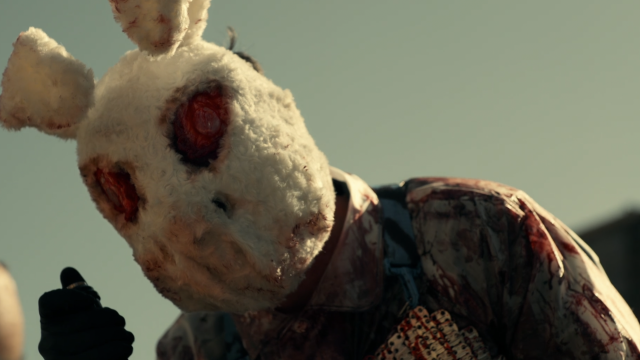My Purge adventures conclude with 2021’s ambitious The Forever Purge, which feels as grimly prophetic as the rest of the series. The first film was a limited-scale horror thriller with touches of social commentary, satire, and thoughtful worldbuilding; gradually, over the course of five films, the series has become something more along the lines of “propulsive social science fiction horror-action.” The worldbuilding elements have amped up as the Purge has developed a specific history and specific consequences, the social commentary has become more pointed and open while still existing as drama rather than just editorializing, and somehow, the franchise managed to produce a prequel that is, astonishingly, actually pretty good. I am, obviously, impressed.
But–to focus in on The Forever Purge–we jump ahead in the story’s timeline to 2048. The passionate, idealistic, principled reform candidate of The Purge: Election Year got her victory and served two terms … and then, spurred on by a bad economy, power fell right back into the hands of the New Founding Fathers, who promptly reinstated the Purge. This could feel like a cheap reversal, but instead, it just feels harshly realistic.
The previous Purge movies took place in the suburbs or the city, but The Forever Purge takes us to rural Texas, where Adela (Ana de la Reguera) and her husband, Juan (Tenoch Huerta)–who crossed the border to escape the cartels–work on a ranch owned by the wealthy Tuckers. The Tuckers are overseen by the kindly but largely hands-off patriarch, Caleb (Will Patton), but most of the day-to-day action falls to his son Dylan (Josh Lucas). Dylan is racist in a “would gripe endlessly about critical race theory” way, pettily pushing Juan’s buttons and thinking everybody should just “stick with their own kind.” But he’s also no fan of the Purge or the NFFA: he doesn’t have any rage brewing, just annoyance. He and his family hole up in their luxurious ranch house for the night, Juan and Adela pay a fee to stay in a guarded compound, and we all hear some gunfire in the distance.
And just like that, it’s over. It’s daylight on the day after the Purge, and people are starting to hose the blood off the sidewalks and get ready to restart normal life again–and then the slaughter starts up again. It’s the “Forever Purge” (hey, that’s the name of the movie!), also known as “Purge Ever After,” a coordinated–it even has a hashtag, because of course it does–white supremacist movement to purge America once and for all of everyone who doesn’t fit their narrow mold of humanity (or who fits it but has nonetheless incurred pissed one of them off anyhow). This time, they have no intention of letting anyone close Pandora’s box. This leads to an interesting split with the NFFA, who have, for multiple movies now, used the Purge as a way to winnow down the poor but who now have to declare martial law to deal with their own voters going haywire.
The New Founding Fathers are a resolutely, deliberately evil party, but they’re establishment evil; they need the superficial structure of the world to stay mostly the same even as they ruin and end lives. The Forever Purgers are apocalyptic–but their chaotic danger is the one thing that makes Canada and Mexico temporarily open their borders to fleeing Americans. Good luck getting that deal on the old Purge Nights. Make a murder day once a year, and everyone will act like it’s normal. Let it spill over, and everyone panics. As horrific as the Forever Purgers are, there’s something bleakly satisfying about seeing them illuminate the mealy-mouthed hypocrisy of the NFFA and bring the whole system crashing down through a sheer maniacal embrace of its central tenets.
All of this, of course, is bound to remind you of real-life events, but The Forever Purge does a good job grounding all this in its own in-series history, and it feels like a sadly natural extrapolation of what’s come before, not a one-to-one translation of America as we know it. It’s weirdly impressive for a movie to be this blatant in its political stance and yet still feel story-driven. As much as the series has evolved, and as much complexity and ambition as it’s taken on, its commitment to thrills remains the same.
The characters are maybe the weakest part of The Forever Purge: they get a little bit of nuance, but they don’t grab your attention in the same way Frank Grillo’s Leo did in two of the previous films. But this has some exceptionally gripping, horrifying, and tense sequences, from Adela finding out about the Forever Purge via having a sudden trap sprung on her (this is a little too Saw-esque and doesn’t even make that much sense, but I’ll admit to liking it anyway) to a desperate attempt to make it to the El Paso border crossing in time despite the waves of parked and wrecked cars blocking the road. The Texas landscape also looks particularly sharp here and makes for some of the series’ most distinctive visuals. Ultimately, it takes a solid second place in my series ranking, just beneath The Purge: Anarchy.
The Forever Purge is streaming on HBO Max.

